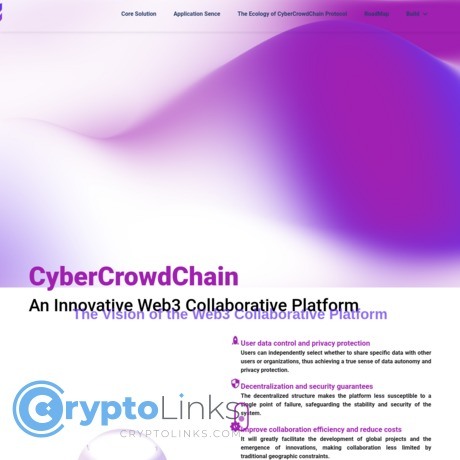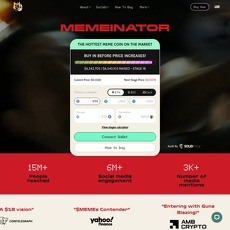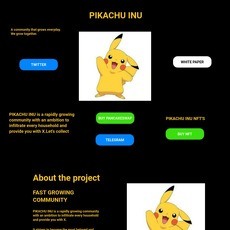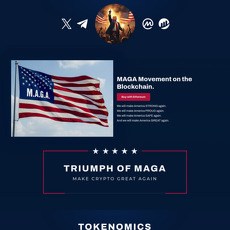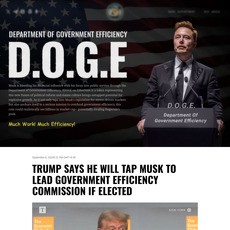CyberCrowdChain Review
CyberCrowdChain
cybercrowdchain.org
If your website is on the scam list and you think that you are not a scammer, contact us. After you provide us with all the proof that you are in Crypto World with good intentions, we will delist you. Usually, you get in this category because you are hiding your team, you have a bad reputation(you are tricking, deceiving, scamming people), and you haven't got a written project whitepaper or is a shitty one....
Their Official site text:
CyberCrowdCoin 1
An Innovative Web3 Collaborative Platform
CyberCrowdCoin
An Innovative Web3
Collaborative Platform
CyberCrowdCoin 2
An Innovative Web3 Collaborative Platform
Content
4.Ecological Co-constructor
5.Roadmap
Platform developers
Protocol developers
Protocol operators
Web2 service provider
Web3 service providers
Offline service providers
6.Economic models
6.1 Profit model
6.2 Pass model
6.3 Percentage of distribution
7.Disclaimer
1.Preface
2.CyberCrowdCoin Collaboration Platform
1.1 Background and challenges
1.2 The vision of the Web3 collaborative platform
2.1 Decentralized collaboration
2.2 Decentralized operations
2.3 Decentralized management
3.System Architecture
3.1 Infrastructure layer
3.2 System protocol layer
3.3 Platform application layer
CyberCrowdCoin 3
An Innovative Web3 Collaborative Platform
Following the rapid development of blockchain technology and cryptocurrencies,
Web3 is leading the way into the future of global digitization with its decentralized,
transparent, and secure nature. The traditional Web2 model has gradually revealed
its limitations and problems with this emerging Internet era. The Web2 platforms are
usually controlled by centralized companies or organizations, which makes users'
data and privacy vulnerable to invasion, and presents a single point of failure and
trust issues. The limitations of this centralized model have forced us to seek more
open and decentralized ways of collaborating.
The purpose of this whitepaper is to present our development of the Web3
Collaboration Platform, a new digital ecosystem designed to change the way
traditional collaboration is done, address the limitations of the Web2 model, and
provide more advantages and convenience to users and organizations.
1. Preface
CyberCrowdCoin 4
An Innovative Web3 Collaborative Platform
1.1 Background and challenges
Within the traditional Web2 model, collaboration usually relies on centralized platforms or
companies. These platforms are responsible for storing and managing users' data and
information, as well as providing transactional and collaborative functionality. However,
there are many problems with this centralized structure:
a. Centralization and data dependency
It is common for the Web2 model to rely on a small number of centralized platforms or
companies to manage and store users' data. These platforms accumulate large amounts of
user data, putting users' personal information and privacy at risk. At the same time, the
monopoly status of these platforms may also lead to data monopolization and unfair
competition, limiting users' right to choose and the free flow of data.
b. Confidence issues
As centralized platforms own a large amount of user data and transaction information, users
are forced to entrust their personal information and assets to these platforms. Nevertheless,
the lack of transparency and credibility raises questions about users' trust in these platforms.
Issues such as data breaches, manipulation, and misuse often leave users in limbo.
c. Single point of failure and security breaches
The centralized Web2 platform has the risk of a single point of failure. Once the platform
fails, suffers hacking, or is shut down, it will paralyze the entire system, affecting the normal
use of users and data security. Moreover, due to its centralized nature, the Web2 platform
becomes an easy target for attackers, which could expose security vulnerabilities that could
threaten users' assets and data.
d. Inter-mediation costs and efficiency
The collaboration in the Web2 model usually depends on a third-party intermediary, which
raises the cost and complexity. The involvement of intermediaries may lead to transaction
lags and increased fees, as well as increased risk and time-consuming transactions.
e. Geographical and cultural constraints
In the traditional Web2 model, collaboration is often limited by geography and culture. With
regulatory and cultural differences between countries, cross-border collaboration, and
communication is likely to become complex and difficult, hindering the development of
global collaboration and innovation.
CyberCrowdCoin 5
An Innovative Web3 Collaborative Platform
All these contexts and challenges push us to rethink and explore a new collaboration model,
a more open, decentralized, and secure Web3 collaboration platform. The development of
Web3 provides new opportunities and possibilities to address these issues, and we look
forward to creating a more autonomous, secure, efficient, and global digital collaboration
ecosystem led by Web3.
1.2 The vision of the Web3 collaborative platform
Our vision is to construct a future-leading decentralized collaboration platform based on
Web3 technology, which will break the traditional collaboration model and create a new
digital ecosystem. We strive to solve the various problems and pain points that exist in the
Web2 paradigm, bringing unprecedented advantages and convenience to users and
organizations.
a. User data control and privacy protection
On our Web3 Collaboration Platform, users will have absolute control over their data.
Personal data will be stored in encrypted form in a distributed blockchain network that only
authorized participants can access and use. Users can independently select whether or not
to share specific data with other users or organizations, thus achieving a true sense of data
autonomy and privacy protection.
b. Decentralization and security guarantees
We will firmly promote the concept of decentralization and build a fully decentralized model
of collaboration through smart contracts and blockchain technology. Smart contract will
ensure that transactions and decisions made in collaboration are automated and
unmediated, thereby reducing potential trust issues and risks. The decentralized structure
makes the platform less susceptible to a single point of failure, safeguarding the stability and
security of the system.
c. Global cooperation and the drive for innovation
Our Web3 Collaboration Platform will serve as a global open ecosystem, providing a
borderless collaboration arena for users and organizations. Without being limited by geogr-
CyberCrowdCoin 6
An Innovative Web3 Collaborative Platform
aphy and borders, users can easily co-create value with partners from all over the world. It
will greatly facilitate the development of global projects and the emergence of innovations,
making collaboration less limited by traditional geographic constraints.
d. Improve collaboration efficiency and reduce costs
Our platform will leverage the features of Web3 to increase the efficiency of collaboration
and reduce intermediary costs. By automatically executing smart contract, the rights and
interests of all parties in the cooperation will be accurately safeguarded, and disputes and
controversies will be reduced. Without the necessity of a third-party intermediary,
transactions, and decisions will be more efficient and transparent, saving time and resources,
thus creating more economic value for users and organizations.
e. Community governance and democratic decision-making
We encourage users and participants on the platform to engage in community governance
to form a mechanism for democratic decision-making. Users can impact the development
and rule-making of the platform by voting and contributing to ensure the fairness and
openness of the platform. This decentralized governance structure will encourage
community participation and innovation, making the platform healthier and more
sustainable.
Then, we will introduce our platform architecture, technical features, and realization path in
detail, presenting a new future of the Web3 collaboration platform for users and partners.
Working on our Web3 Collaboration
Platform, we want to create a true
digital collaboration ecosystem that
tightly connects all participants,
facilitates the sharing of knowledge,
resources, and value, and creates a
lasting and meaningful collaboration
experience for organizations and
users. We firmly believe that Web3's
model of synergy and collaboration
will lead the way to the future of the
digital economy, bringing positive
change and progress to the global
community.
CyberCrowdCoin 7
An Innovative Web3 Collaborative Platform
2.CyberCrowdCoin collaboration platform
CyberCrowdCoin is a decentralized collaborative platform. It leverages the user base and
infrastructure of the Web2 centralized service network and connects and integrates with
blockchain and Web3 infrastructure to build an open, shared, and collaborative
infrastructure to achieve the goals of decentralized collaboration, decentralized operation,
and decentralized governance.
CyberCrowdCoin lowers the threshold for users by adopting an open interface so that Web2
users can easily experience Web3 services and gradually switch to Web3 services. Through
introducing a decentralized collaboration mechanism, it facilitates efficient exchanges and
value sharing among core elements (e.g., commodities, money, tasks, creativity, etc.) and
achieves fairer and more efficient collaboration. The platform also establishes a multi-level
governance system, including a collaborative DAO and a decentralized collaboration
mechanism, to achieve more effective decentralized governance and operations, thus
ensuring the platform's continued stability and development.
2.1 Decentralized collaboration
Through the decentralized collaborative mechanism of CyberCrowdCoin, which revolves
around the core elements of commodities, money, tasks, and creativity, consumers can find
good-value and low-priced commodities with the help of a large number of users. Merchants
can directly face a larger number of users and sell commodities more efficiently, at a lower
cost, and with a higher profit. Such a decentralized and collaborative approach promotes
fairer and more efficient cooperation, providing community members with broader
opportunities for participation and creativity. We plan to take a series of measures aimed at
making it easy for more users to experience Web3 services and get rid of the monopoly of
Web2 giants. CyberCrowdCoin plans to take the following measures:
CyberCrowdCoin 8
An Innovative Web3 Collaborative Platform
Bind to an existing
Web2 account
Extend the existing
Web2 platform
Improve existing
payment channels
a. Bind to an existing Web2 account
Through the open interface, the user identity of the Web2 platform is bound with the
decentralized identity of CyberCrowdCoin, so that users do not need to learn about
blockchain wallet-related knowledge to enjoy Web3 services easily.
b. Extend the existing Web2 platform
Provide extensions and plug-ins for common open-source platform software to equip these
systems with CyberCrowdCoin decentralized collaboration capabilities, allowing users to use
Web3 services on existing platforms seamlessly.
c. Improve existing payment channels
The use of CyberCrowdCoin abstract accounts reduces the challenges of using and holding
crypto passes for users and facilitates the use of the CyberCrowdCoin platform's services and
other Web3 applications.
2.2 Decentralized operations
During the Web3 era, DAOs (Decentralized Autonomous Organizations) became an iconic
feature; however, as platforms scale, current DAOs may face long-term operational and
governance challenges. In order to solve this problem, we introduced collaborative DAO and
decentralized collaboration mechanisms to find a more effective solution.
Synergy DAO is our innovative decentralized, bottom-up, multi-tiered governance system. It
is similar to a well-functioning democracy in reality, enabling every participant to play a role
and have the opportunity to be involved in the decision-making process. Such a
decentralization mechanism ensures that power on the platform is not concentrated in the
hands of a few but is shared by a wide range of community members, providing a more
robust foundation for the platform's development.
CyberCrowdCoin 9
An Innovative Web3 Collaborative Platform
By means of the decentralized collaboration mechanism, we solve the current problem of
lack of collaboration in DAOs.Through this mechanism, participants can communicate and
cooperate efficiently, and the core elements (e.g., goods, money, tasks, ideas, etc.) are closely
connected, thus realizing a fairer and more efficient synergy. Such decentralized synergy
facilitates consensus formation in the community and makes the direction of the platform
more democratic and transparent.
2.3 Decentralized management
We have not only established a collaborative DAO but also adopted a decentralized
collaborative mechanism to strengthen the governance system further in order to achieve
continued stability and growth as the platform scales up.
Decentralized governance means that the power to make decisions is no longer concentrated
in a centralized body or in the hands of an individual but is instead shared by the global
community through smart contract and blockchain technology. As such, community
members will not only have a greater voice but will also be able to express their opinions and
suggestions more effectively, ensuring that the direction of the platform will be better
aligned with the overall consensus.
We have introduced a decentralized synergy mechanism in our governance system, which
closely integrates the governance process of the platform with the synergy of the community.
By means of this mechanism, community members can participate in the decision-making
and implementation process, thus ensuring fairness and transparency in decision-making.
This decentralized governance model not only enhances community cohesion but also
provides a sustainable basis for the long-term operation of the platform.
As a whole, through the decentralized collaborative mechanism and collaborative DAO, we
have explored a more inclusive decentralized operation and governance model in the Web3
era to safeguard the robust development of the platform and provide broader opportunities
for community members to participate and create.
CyberCrowdCoin 10
An Innovative Web3 Collaborative Platform
CyberCrowdCoin serves as a decentralized collaborative platform with the core objectives of
crowdsourcing, creating, funding, and supporting. By investing time, energy, and money,
users can participate in decentralized collaborative tasks, and the results of collaboration are
presented in the form of commodities, NFT, etc. Users participate in the distribution of
revenues from the results of collaboration according to the degree of contribution.
CyberCrowdCoin is a Web3 platform based on decentralized collaborative consensus, which
introduces collaborative DAO and decentralized collaborative mechanism, and establishes a
multi-level governance system to achieve more effective decentralized governance and
operation. By opening up interfaces to bind with Web2 identities, adopting abstract wallets
to solve payment challenges, as well as providing open-source system extensions and plugins, it lowers the threshold for users to use the system. A core technology includes
Collaborative Operating System, Modular Blockchain Technology, Cross-Chain/Cross-Layer
Technology, etc., which supports CyberCrowdCoin to realize an efficient, secure, and scalable
collaborative ecosystem.
By adopting a layered architecture, the CyberCrowdCoin platform system consists of an
infrastructure layer, a system protocol layer, and a platform application layer, with each
protocol layer consisting of a series of subsystems.
3.1 Infrastructure layer
The infrastructure layer includes: the Web2 aggregation system, the Web3 aggregation
system, theCross-Chain/Cross-Layer technology, the smart contract library, and the modular
blockchain technology.
3.System architecture
CyberCrowdCoin 11
An Innovative Web3 Collaborative Platform
a. Web2 aggregation system
The Web2 Aggregation System serves as a key bridging role in the CyberCrowdCoin platform,
designed to aggregate the various network resources in the Web2 space and provide
interfaces and interoperability to Web3.
The Web2 Aggregation System makes full use of the large amount of network resources
accumulated in the Web2 era, including social media data, online services, e-commerce
platforms, digital content, and so on. By aggregating these diverse Web2 resources, the
CyberCrowdCoin platform is able to provide users with richer and more diverse collaborative
and cooperative scenarios and to provide broader participation and support for
crowdsourcing, funding, creating, and other collaborative tasks.
The Web2 aggregation system provides an important interface for Web3, realizing the
integration and interoperability between Web2 and Web3. With this interface, Web3
applications and smart contract can seamlessly access and call network resources in the
Web2 domain, thus realizing more comprehensive and efficient data acquisition and
processing. This makes the Web3 ecosystem richer and more diverse in terms of resource
utilization and promotes the development and popularization of the Web3 platform.
The Web2 aggregation system also extends the application scenarios and user stickiness of
the CyberCrowdCoin platform. Through the integration of Web2 and Web3 Collaboration,
users are able to accomplish more tasks and interactions on a unified platform without
having to switch between different applications frequently. This highly integrated experience
brings convenience to users and increases their motivation to participate in collaborative
work.
b.Web3 aggregation system
The CyberCrowdCoin Collaboration Protocol is the core protocol in the CyberCrowdCoin
platform and is given the important role of the underlying operating system for the
collaboration of everything in the Web3 era. As a collaborative operating system, it is not just
an ordinary protocol but a highly intelligent, fully collaborative infrastructure that provides
strong support for the platform's various functions and services.
This collaborative operating system plays a core scheduling role in the CyberCrowdCoin stack,
which is based on a micro-kernel architecture and achieves a high degree of modularity and
flexibility, providing efficient management and scheduling capabilities for the platform's
multi-level governance system and functional modules.
It is unique in that it fully supports the key infrastructure necessary for collaboration in the
Web3 era.It includes the Collaboration DAO, which makes the platform's governance and
decision-making mechanisms more decentralized and democratized. Decentralized Synergy,
which promotes users' crowd-sourcing, crowdfunding, and crowd-sourcing activities on the
platform to achieve wider participation and collaboration.Meta-universe, building a virtual
CyberCrowdCoin 12
An Innovative Web3 Collaborative Platform
multi-dimensional space that connects users with the infinite possibilities of the digital
world. Decentralized finance, providing users with safe and transparent financial services and
promoting the development of DeFi and other innovative fields.
Supported by such a powerful infrastructure, the CyberCrowdCoin Collaboration Protocol
provides a comprehensive solution for collaboration in the Web3 era and will continue to
drive large-scale collaborative innovation and value exchange on a global scale. The
intelligent collaborative operating system plays a vital role in facilitating collaborative DAO
governance, optimizing collaborative processes, managing collaborative tasks, and
integrating collaborative tools, driving the popularity and progress of collaborative work. The
intelligent collaborative operating system plays a vital role in facilitating collaborative DAO
governance, optimizing collaborative processes, managing collaborative tasks, and
integrating collaborative tools, driving the popularity and progress of collaborative work.
c.Cross-Chain/Cross-Layer technology
With the introduction of advanced Cross-Chain technology, CyberCrowdCoin realizes
seamless support for cross-chain interactions between Layer 1 public chains and Layer 2, thus
significantly improving cross-chain efficiency. It implies that users are free to transfer and
exchange digital assets and data between different blockchain networks on the
CyberCrowdCoin platform without being restricted to a specific public chain ecosystem. The
capability of such cross-chain interactions greatly facilitates the liquidity and availability of
digital assets while enhancing synergies between different blockchain networks.
Apart from supporting cross-chain interaction between mainstream public chains Layer 1,
CyberCrowdCoin also leads the industry in innovation with its original Cross-Chain/CrossLayer technology. It further extends the scope of cross-chain interactions, making it easy for
Layer 2 to interact with each other and between Layer 1 and Layer 2. With this innovative
technology, CyberCrowdCoin realizes more efficient and convenient digital asset
interoperability and data transfer, providing users with a brand new blockchain experience.
Such seamless cross-chain support and efficient interaction builds a powerful bridge to
CyberCrowdCoin's collaborative ecosystem, enabling the integration and collaboration of
different users, projects, and assets on a unified platform. The aggregation protocol layer and
transaction protocol layer in CyberCrowdCoin's protocol layer give full play to the advantages
of cross-chain technology, realizing the seamless connection and efficient operation of
various types of collaborative work in the Web3 era. It enables CyberCrowdCoin to become
an open, inclusive, and efficient decentralized collaborative platform, which brings broader
development space and innovation opportunities for users.
It fully supports the key infrastructure necessary
for collaboration in the Web3 era.
CyberCrowdCoin 13
An Innovative Web3 Collaborative Platform
d. Smart contract library
Within the CyberCrowdCoin platform, the Collaborative DAO is the core mechanism of its
decentralized governance, providing a way for participants to engage in important matters
such as community governance, decision-making rules, and resource inputs. The governance
system is more flexible and efficient. In order to meet the governance needs of DAOs of
different sizes, CyberCrowdCoin collaborative DAO adopts an infinite multi-level DAO tree
and task tree structure.
Nevertheless, as the scale of DAO governance increases, and the complexity of collaborative
tasks increases, the traditional smart contract faces significant challenges in terms of security,
performance, and scalability. For overcoming these problems, CyberCrowdCoin adopts smart
contract modularization technology, which divides the collaborative DAO contract into
multiple modules, allowing each module to run independently and interact seamlessly with
other modules. Such a modular design greatly improves the maintainability and flexibility of
smart contract while reducing the complexity of the contract code.
Through smart contract modularization technology, CyberCrowdCoin synergistic DAO
contract set can more efficiently deal with complex synergistic tasks and governance rules,
ensure the security of DAO common assets, and provide a more stable, secure, and highperformance decentralized synergistic platform. With this innovative technology,
CyberCrowdCoin's collaboration ecosystem has laid a solid foundation, enabling the platform
to meet future development challenges better and bring users a better collaboration
experience.
e. Modular blockchain technology
At the infrastructure layer of the CyberCrowdCoin platform, modular blockchain technology
is the key technical support that brings a high degree of flexibility and scalability to the entire
stack. It enables CyberCrowdCoin to adapt to the complex needs of various large-scale
collaboration scenarios, providing users with the powerful ability to operate efficiently and
decentralize collaboration.
CyberCrowdCoin 14
An Innovative Web3 Collaborative Platform
The central idea of modular blockchain technology is to decouple individual functional
modules so that they can operate independently of each other while interacting and
combining together seamlessly. This means that CyberCrowdCoin's protocol stack is no
longer a rigid single entity but a flexible componentized system. Participants can customize
their collaboration experience by selecting and integrating applicable functional modules
according to their actual needs.
Powered by modular blockchain technology, the CyberCrowdCoin platform is able to respond
quickly to market changes and user needs, providing tailored solutions for different industries
and communities. Whether it's crowdsourcing, creating, funding, decentralized finance,
meta-universes, etc., CyberCrowdCoin provides the best fit for a variety of large-scale
collaborative scenarios.
Such flexibility and scalability not only provide a superior user experience but also lays a solid
foundation for the sustainable development of the CyberCrowdCoin platform. With the
continuous evolution of the technology and ecosystem, CyberCrowdCoin will continue to
expand with new modules and features to meet the growing demand for collaboration and
drive decentralized collaboration toward a broader future.
The above are the core components of the infrastructure layer, the technologies, and systems
that provide a solid foundation for the efficient operation and decentralized collaboration of
the CyberCrowdCoin platform. In order to better understand the overall system architecture
and detailed subsystems, please provide more relevant information or a specific system
architecture diagram.
CyberCrowdCoin 15
An Innovative Web3 Collaborative Platform
3.2 System protocol layer
There are multiple key components and protocols in the system protocol layer of the
CyberCrowdCoin platform that work in tandem to support the platform's features and
services, enabling decentralized collaboration and value exchange.
In the system protocol layer, it covers the collaboration protocol layer, data protocol layer,
transaction protocol layer, and aggregation protocol layer. These layers contain rule
protocols, workflow protocols, project management protocols, and collaboration tools,
which provide powerful support for the execution and management of collaborative tasks.
Meanwhile, the data protocol layer ensures the operation and privacy of data assets, the
transaction protocol layer supports various transaction types, and the aggregation protocol
layer integrates Web2 and Web3 to work together to enhance the application scenarios and
user stickiness of the Web2 platform. Furthermore, the protocol layer contains multiple subprotocols to provide rich functions and services for the system.
Collaboration protocol layer:
The Co-Protocol Layer is the core protocol of the protocol layer and is responsible for bridging
the channel between Web2 and Web3. It contains several sub-protocols:
(1) Rules protocols:
The protocol is designed to parse and execute various community governance, management,
business, and transaction rules. It adopts a combination of on-chain and off-chain models to
ensure the effective implementation of rules and adaptation to the needs of different
scenarios.
CyberCrowdCoin 16
An Innovative Web3 Collaborative Platform
(2) Workflow protocol:
Automate the execution of collaborative processes, leveraging artificial intelligence for
analysis and optimization. Similarly, the protocol utilizes a combined on-chain and off-chain
model to increase efficiency and flexibility.
(3) Project management protocol:
protocol is intended to manage the lifecycle of collaborative tasks, including goal setting, plan
development, progress management, benefit distribution, and a system of rewards and
penalties. It can help to achieve efficient execution of tasks and effective allocation of
resources.
(4) Collaboration tools:
Collaboration tools integrate Web2 and Web3 functionality with respect to document
management, communication, payment, storage, and so on. These tools provide
comprehensive support to facilitate user participation in collaborative tasks and
communication.
(5) Collaboration DAO layer
Community Governance DAO: This protocol is used for the decentralized governance of the
CyberCrowdCoin community, through which community members can make decisions on
governance rules, formulate development routes, commit resources, and other major
matters to achieve community autonomy.
Task DAO: This protocol is used to govern organizations that collaborate on tasks. Task DAOs
are divided into an infinite number of levels in a tree structure that supports a bottom-up
decentralized governance system to help ensure efficient execution and division of tasks.
Data protocol layer:
(1) Data protocol:
The data protocol is the core that supports the operation of data assets. It ensures the
privacy, notarization, transparency, security, and efficiency of the data. At the same time, the
ownership of the data is in the hands of the user, ensuring the security and control of the
user's data.
(2) Data market:
The protocol enables participants to buy and sell data, exchange data, and data derivatives
through data marts. Access to data is managed through NFT authorization, enhancing the
security and transparency of data transactions.
Transaction protocol layer:
The transaction protocol layer is the core transaction processing hub of the platform, which
supports e-commerce transactions, NFT transactions, fiat + crypto coin payments, credit
payments, as well as crowdsourcing, crowdfunding, crowdsourcing, and other order types. It
ensures secure and efficient transactions.
CyberCrowdCoin 17
An Innovative Web3 Collaborative Platform
Abstract wallet payment protocol: the protocol supports a smart contract wallet payment
scheme, providing flexible payment methods user-friendly transaction experience.
Aggregation protocol layer:
It integrates the functions of Web2 Aggregator and Web3 Aggregator to integrate the
collaborative work of Web2 and Web3, thus enhancing the application scenarios and user
stickiness of the Web2 platform.
Apart from the above protocols, the CyberCrowdCoin protocol family also includes: the service
protocol layer, product protocol layer, and open platform protocol layer. The layers of protocols
are interconnected and together form the complete functionality and services of the
CyberCrowdCoin platform. Each sub-protocol has its own specific functions and goals and works
in concert to form a powerful decentralized collaboration ecosystem.
The system protocol layer is the core part of the CyberCrowdCoin platform, and the various
components and protocols work together to support the various functions of the platform and
realize decentralized collaboration and value exchange among users. The platform creates a
variety of decentralized collaboration scenarios for global users through these agreements,
driving the development and sustainable prosperity of the digital economy.
3.3 Platform application layer
As regards the platform application layer, many exciting decentralized collaboration scenarios
have emerged based on CyberCrowdCoin's decentralized collaboration protocol, such as
decentralized classified ads platforms, decentralized B2B collaboration platforms, decentralized
social e-commerce companies, and decentralized direct marketing platforms. Those scenarios
will drive global users to participate in innovation and value creation, accelerating the progress
and prosperity of human society. By decentralizing the nature of these scenarios, they will bring
higher transparency, fairness, and security, making collaborative work more inclusive and
sustainable. The CyberCrowdCoin platform becomes an important hub for connecting innovators,
participants, and value creators and creates more opportunities and room for development for
users around the world.
CyberCrowdCoin 18
An Innovative Web3 Collaborative Platform
Powered by the decentralized collaboration protocol based on CyberCrowdCoin, many
exciting decentralized collaboration scenarios will emerge globally, which will revolutionize
business models and socialization and create more opportunities and development space for
users. The following are some of the decentralized collaboration scenarios incubated at the
platform application layer:
(1) Decentralized classified ads platform:
There is no longer an intermediary on CyberCrowdCoin. Everyone can quickly create and run
their own classifieds station. It will lead to a new model of exchanging goods, ideas, and
creative products, allowing users to connect directly without having to earn a price difference
through a middleman, enabling more autonomous and flexible transactions.
(2) Decentralized B2B collaboration platform:
With CyberCrowdCoin's synergistic protocol, decentralized synergistic e-commerce, and
trading protocol, B2B platforms will no longer be limited to information display and trading
functions. Both supply and demand can be efficiently summarized, forming a synergistic
ecology upstream and downstream of the industry chain, stimulating more innovation and
cooperation opportunities, and enhancing the overall efficiency of the industry chain.
(3) Decentralized social e-commerce:
With the combination of collaborative e-commerce and crowdsourcing mechanism, every
user has the opportunity to become a distributor, realizing everyone's participation in
distribution. With the help of a mass creation mechanism, the wisdom of the group will push
the communication program to the climax, realizing the active participation of everyone in
communication and accelerating product promotion and market expansion.
(4) Decentralized direct marketing platform:
CyberCrowdCoin's coordinated DAO, collaborative tasks, and crowdsourcing mechanisms
provide solutions for scenarios such as direct sales and multi-level distribution. This
effectively circumvents the problems of fund security and high handling fees in the traditional
model and makes direct sales more fair and transparent.
(5) Collaboration business platform:
CyberCrowdCoin's collaboration protocols and collaborative DAOs make it possible to
collaborate and innovate efficiently between different organizations. The rich set of
collaboration tools enables anyone to build their own collaborative business platform based
on these components, accelerating business processes and project management and
facilitating more collaboration and business development.
(6) Decentralized crowd creation/crowdsourcing/funding platforms:
Through CyberCrowdCoin's decentralized and synergistic mechanism, crowd creation,
crowdsourcing, and funding are organically combined. Such an integrated platform can
support large-scale collaborative innovation and fund-raising and promote the participation
of all sectors of society in solving major problems.
CyberCrowdCoin 19
An Innovative Web3 Collaborative Platform
(7) Decentralized Finance (DeFi):
The CyberCrowdCoin protocol delivers strong support for decentralized financial services and
brings together various DeFi, SocialFi, and GameFi services. Investors can fully access and invest
in all kinds of DeFi products on CyberCrowdCoin, lowering the threshold of financial services and
promoting more people to participate in innovation in the financial sector.
(8) Decentralized network charity:
Due to CyberCrowdCoin's decentralized synergy mechanism, charity and poverty alleviation
will become more efficient and transparent. With crowdsourcing, funding, and crowd
creation functions, the advancement of decentralized charity projects is achieved, allowing
recipients to participate in collaborative creation tasks, gain lasting earning power, and
achieve self-worth.
Apart from the application scenarios described above, relying on the platform's ability to
integrate Web2 and Web3 resources, the CyberCrowdCoin protocol can be applied to a wider
range of areas. These innovative decentralized collaboration scenarios will promote global
user participation in innovation and value creation, accelerating the progress and prosperity
of human society. By decentralizing the nature of these scenarios, these scenarios will lead
to greater transparency, fairness, and security, making collaboration more inclusive and
sustainable. The CyberCrowdCoin platform will become an important hub for connecting
innovators, participants, and value creators.
CyberCrowdCoin builds a highly autonomous and decentralized collaborative platform with
the effective combination of the infrastructure, system protocol, and platform application
layer. In the infrastructure layer, the Web3-era Collaborative Operating System is introduced
to support various infrastructures such as Collaborative DAO, Decentralized Collaboration,
Meta-Universe, and Decentralized Finance, and the Modular Blockchain Technology and
Cross-Chain/Cross-Layer Technology are also adopted to ensure that the system is efficient,
secure, and scalable. The smart contract store further addresses the security, performance,
and scalability of collaborative DAOs.
At the system protocol layer, a series of powerful protocols and data processing modules,
such as rule protocol, workflow protocol, a project management protocol, and transaction
protocol, as well as the collaborative DAO layer and data protocol layer, is constructed to
provide comprehensive support for the execution, management, and data processing of
collaborative tasks. The aggregation protocol layer integrates Web2 and Web3 to work
together and enhance the user experience. The layers are interconnected by multiple subprotocols to form a complete collaborative ecology.
In the platform application layer, the CyberCrowdCoin platform has incubated a variety of
innovative decentralized collaboration scenarios, such as classified ads platforms, B2B
collaboration platforms, social e-commerce, and direct marketing platforms, creating more
CyberCrowdCoin 20
An Innovative Web3 Collaborative Platform
opportunities and development space for global users. There is also strong support for areas
such as decentralized financial services, online philanthropy, and DeFi. The realization of
these decentralized collaborative scenarios will drive social progress and prosperity while
bringing greater transparency, fairness, and security. The CyberCrowdCoin platform becomes
an important hub connecting innovators, participants, and value creators, making
collaboration more inclusive and sustainable and leading a new era of collaboration in the
Web3 era.
In the CyberCrowdCoin platform's ecosystem, there are multiple players working together to
co-create and drive the development and operation of the protocol. It mainly includes the
roles of platform developers, protocol developers, protocol operators, Web2 service
providers, Web3 service providers, and offline service providers. The following is a detailed
description of these ecological co-builders and their roles:
4.Ecological co-constructor
CyberCrowdCoin 21
An Innovative Web3 Collaborative Platform
(1) Platform developers
The platform developers are the core development team of the CyberCrowdCoin platform
and are responsible for developing and maintaining the core CyberCrowdCoin infrastructure
components, including:
Web2 Aggregation System: Aggregates Web2 network resources and provides interfaces
for Web3.
Web3 Aggregation System: supports infrastructure such as collaborative DAO,
decentralized collaboration, meta-universe, and decentralized finance.
Cross-Chain/Cross-Layer Technology: Seamlessly supports cross-chain interaction
between Layer 1 public chain and Layer 2 to improve cross-chain efficiency.
Smart contract library: solves the security, performance, and scalability problems of
collaborative DAO.
Modularized blockchain technology: supports combinable, pluggable, and extensible
protocol stacks to meet the needs of large-scale collaboration.
(2) Protocol developers
Protocol developers are teams or individuals who follow the CyberCrowdCoin protocol and
develop related protocols and products. They create and maintain protocols and platforms
including but not limited to the following:
Aggregation protocol: Aggregate dispersed information to provide a global perspective
and data support for other services.
Collaboration protocol: Promote collaboration and value exchange, and build a
decentralized cooperation mechanism.
Transaction protocol: support the transaction and circulation of digital assets to realize
the freedom and efficiency of economic activities.
Data protocol: Manage and process various types of data to provide users with
personalized experiences and services.
Open platform protocol: a protocol that supports third-party developers to access the
CyberCrowdCoin platform.
(3) Protocol operators
The protocol operator is responsible for the operation of the CyberCrowdCoin protocol nodes
to ensure the security and stability of the CyberCrowdCoin decentralized network. On top of
that, they are responsible for the operation of products developed under the
CyberCrowdCoin protocol, including but not limited to classified ads, social e-commerce, B2B
e-commerce, B2C e-commerce, C2C e-commerce, crowdsourcing, funding, creation, and
other products. The Protocol Operator is the key operator of the CyberCrowdCoin platform,
driving the continued development and optimization of the platform.
(4) Web2 service provider
Web2 service providers are Web2 service providers that offer various support and services
for the CyberCrowdCoin platform. They cover a variety of areas, including but not limited to:
CyberCrowdCoin 22
An Innovative Web3 Collaborative Platform
Open source platforms: such as WordPress, etc., provide the basic platform and tools
for CyberCrowdCoin.
E-commerce platform: providing platforms and solutions for e-commerce transactions.
Collaboration platforms: platforms that support collaborative work and teamwork.
Crowdsourcing/funding platform: a platform that facilitates large-scale collaborative
innovation and fundraising.
Social Media: brings social features and user communication channels to the
CyberCrowdCoin platform.
Classified Ads: Provides users with classified ad services and a platform for commodity
exchange.
(5) Web3 service providers
Web3 service providers are service providers that provide support for the decentralized
features and services of the CyberCrowdCoin platform. They are involved in a number of
areas, including but not limited to:
DeFi/GameFi/SocialFi: supports decentralized financial, gaming, and social services.
Domain ENS: Provides decentralized domain name services.
Identity DID: Provides decentralized identity verification and authentication services.
Storage Service IPFS: Provides decentralized data storage solutions for CyberCrowdCoin
users.
Layer2 Network: Provides Layer 2 scaling solution.
Cross-chain: Supports interoperability between different blockchain networks.
Wallet: Provides secure storage and management of digital assets.
Prophecy Machine: Provide external data service for smart contract.
Meta-universe: build a virtual digital universe space.
(6) Offline service providers
Offline service providers provide offline physical services for the CyberCrowdCoin platform
and cooperate with each other to expand the application scenarios of the platform. These
service providers include but are not limited to:
Judicial notarization: Provide legal services and legal consulting, notarization services for
offline transactions.
Marketing: providing marketing strategies and promotion services.
Warehousing and Logistics: Provide storage and safekeeping services for commodities
and transportation and distribution services for commodities.
Insurance and financial management: providing insurance and financial management
services and protection for users.
The above ecological co-builders have their own roles in the CyberCrowdCoin platform and
work together to build a powerful decentralized collaboration ecosystem, providing users
with a new value exchange and social experience. The diversified ecosystem will accelerate
the innovation and development of protocols and advance the prosperity and sustainable
development of the digital economy.
CyberCrowdCoin 23
An Innovative Web3 Collaborative Platform
2024 S3
Cross-Layer Technology
Decentralized crowd creation platform
Modular blockchain formation
5.Roadmap
2023 S3
Web3 Aggregation System
Data Protocol Layer
2023 S4
Web2 Aggregation System
Transaction Protocol Layer
2024 S1
2024 S2
Aggregation Protocol Layer
Data Marketplace
Workflow Protocol
Cross-Chain Technology
smart contract library
Collaboration protocol layer
2024 S4
Cross-chain governance DAO
Collaborative commerce platform
CyberCrowdCoin 24
An Innovative Web3 Collaborative Platform
6.1 Profit model
CyberCrowdCoin's main revenues include: transaction fees and protocol usage fees.
Transaction fees:include transaction fees, NFT transaction fees, data usage fees, and data
transaction fees.
Protocol Usage Fee: For those who provide product services based on CyberCrowdCoin's
protocol, a protocol usage fee is required. The license fee is distributed proportionally
among the licensed developer, the product developer, and CyberCrowdCoin.
6.2 Pass model
The CyberCrowdCoin ecosystem pass is "Cyber Crowd Coin" (symbolized as CCC), with a total of
1 billion pieces.
CCC is mainly used for governance, payment, incentives, and pledges in the CyberCrowdCoin
protocol ecosystem.
(1) Governance
CCC can be used for CyberCrowdCoin DAO governance. The protocol governance of
CyberCrowdCoin is categorized into two types: CyberCrowdCoin protocol DAO and task DAO.
The protocol DAO is used for decision-making on major CyberCrowdCoin protocol matters.
Task DAOs are created for each collaborative task and are used for collaborative task
governance.
The CCC holders can participate in the governance of the Task DAO. The DAO is governed by the
top 100 CCC holders.
6.Economic models
CyberCrowdCoin 25
An Innovative Web3 Collaborative Platform
(2) Payment
CCC can be used to pay for various product services in the CyberCrowdCoin ecosystem, such
as e-commerce transactions, NFT transactions, data transactions, protocol usage, and more.
(3) Incentives
Collaboration incentive: Use CCC to incentivize effective behaviors for participation in
collaborative tasks.
Creation incentive: Use CCC to incentivize valid behaviors for participating in creation
tasks such as crowd creation.
Transaction incentive: For every transaction using CyberCrowdCoin protocol, the
transaction behavior is incentivized with CCC.
Payment incentive: Every payment using CCC will be incentivized with CCC.
Data sharing incentives: CCC will be used to incentivize every active sharing of
contributed data.
Promotion incentive: Use CCC to incentivize participation in CyberCrowdCoin's
promotion program.
Activity incentive: CyberCrowdCoin will launch activities on a regular and irregular basis
and use CCC to incentivize users who participate in the activities.
Protocol development incentives: CCC is used to incentivize developers and projects that
participate in the development of the CyberCrowdCoin protocol.
Protocol use incentives: CCC is used to incentivize projects that use the CyberCrowdCoin
protocol.
(4) Pledge
To use the CyberCrowdCoin protocol, it is necessary to hold and lock up a certain number of
CCCs.
To develop based on the CyberCrowdCoin protocol, it is necessary to hold and lock a certain
number of CCCs.
CyberCrowdCoin 26
An Innovative Web3 Collaborative Platform
6.3 Percentage of distribution
Target Usage Percentage Lock-up period
Private
Equity/IEO
Raise capital through private
investors and exchanges
20 %
Unlocking according to the
lock-up period negotiated with
the investor
Advisors Incentives for advisors with
significant contributions
5 %
Unlocked in equal monthly
installments over 6 months
after the project is opened for
trading in the secondary market
User-Incentives
Incentives for users who
participate in trading,
payments, collaboration,
creation, sharing, locking,
and other activities on the
platform
40 %
Unlocked over 8 years, 5% of
total amount unlocked per year
Partner Incentives
Incentives for partners who
participate in the
development, promotion, and
operation of the platform.
20 %
Unlocked over 4 years, 5% of
total amount unlocked per year
CyberCrowdCoin
Team
Team incentives 15 %
36 months after the project is
opened for secondary market
trading, unlocked in equal
monthly installments.
CyberCrowdCoin 27
An Innovative Web3 Collaborative Platform
添加您的标题
The document is general information of an expository nature about the project and is used to solicit
feedback from investors. CyberCrowdCoin directors, advisors, and legal counsel have the right to
review and revise the document. Please do not copy or distribute any part of this document without
an addendum. There is no part of this document that creates a legal relationship with the recipient of
this document or makes that recipient legally binding or enforceable against CyberCrowdCoin.
Updated versions of this document may be dated and published by CyberCrowdCoin in due course.
The token does not constitute any form of security, business trust unit, collective investment scheme
unit, or any other form of investment. This document does not constitute a prospectus or any form of
the standardized contractual document, and this document is not subject to any jurisdiction of any
form of securities, units of a business trust, or any form of investment institution.
Access to any information in this document or related content requires you to confirm and ensure
your acceptance of the following terms with CyberCrowdCoin:
1. Non-solicitation
This article does not constitute or form any invitation to sell or abet the subscription, promise to pay,
or purchase of any investment product or futures. Neither this article nor any of the contents herein
constitute the basis or foundation of any contract or investment decision.
2. Non-Agreement
This article is not the basis or foundation of any contract or investment decision.
3. Information
Any information, statements, projections, plans, and opinions contained herein that relate to the
anticipated blueprint, development, and related terms and features are screened and updated,
expanded, modified, independently verified, and revised from time to time. Therefore,
CyberCrowdCoin does not guarantee the truthfulness, accuracy, and completeness of any information
provided herein. At the same time, we expect to achieve all the goals mentioned herein, but in the
event of unforeseen special circumstances, these goals may be modified or not achieved without
notice to you.
4. Non-advice
Nothing mentioned herein constitutes legal, financial, tax, or other advice, and we recommend that
you consult the relevant experts separately.
5. Standardize
There is no clear or undecided state of regulation of crypto tokens, including any digital currencies,
digital assets, and blockchain technology, in many administrations. The publication and dissemination
of this article do not imply compliance with relevant laws, guidelines, and treaties. This article has not
been tested or adopted by any regulatory party. In the event of changes to existing laws, regulations,
and/or treaties by the governments of the relevant authorities or the enactment of relevant financial
decisions by fiscal authorities, there may be a material adverse effect on the intended execution of
the operations of the relevant entities referred to herein, or on the entity as a whole.
7.Disclaimer
CyberCrowdCoin 28
An Innovative Web3 Collaborative Platform
CyberCrowdCoin
Embracing the Era of Digital Economy

